Management Report: Theories, Practices, and Leadership Skills
VerifiedAdded on 2020/05/04
|19
|3749
|122
Report
AI Summary
This comprehensive report delves into various aspects of management, covering classical, humanistic, and contingency theories, alongside the theories of Fayol, Mintzberg, and Katz. It explores effective communication strategies, especially in diverse workplaces, and examines corporate social responsibility, ethical behaviors, and the implications of these concepts for organizational success. The report also highlights key leadership components, practices of exemplary leadership, and strategic management approaches, including research-based, market-based, and organization/industrial-based views. The report also includes the different managerial styles and their impact. The report offers insights into various managerial styles, strategic management approaches, and organizational domains. Students can utilize this report, available on Desklib, to understand complex management principles and enhance their understanding of leadership, ethics, and strategic planning.
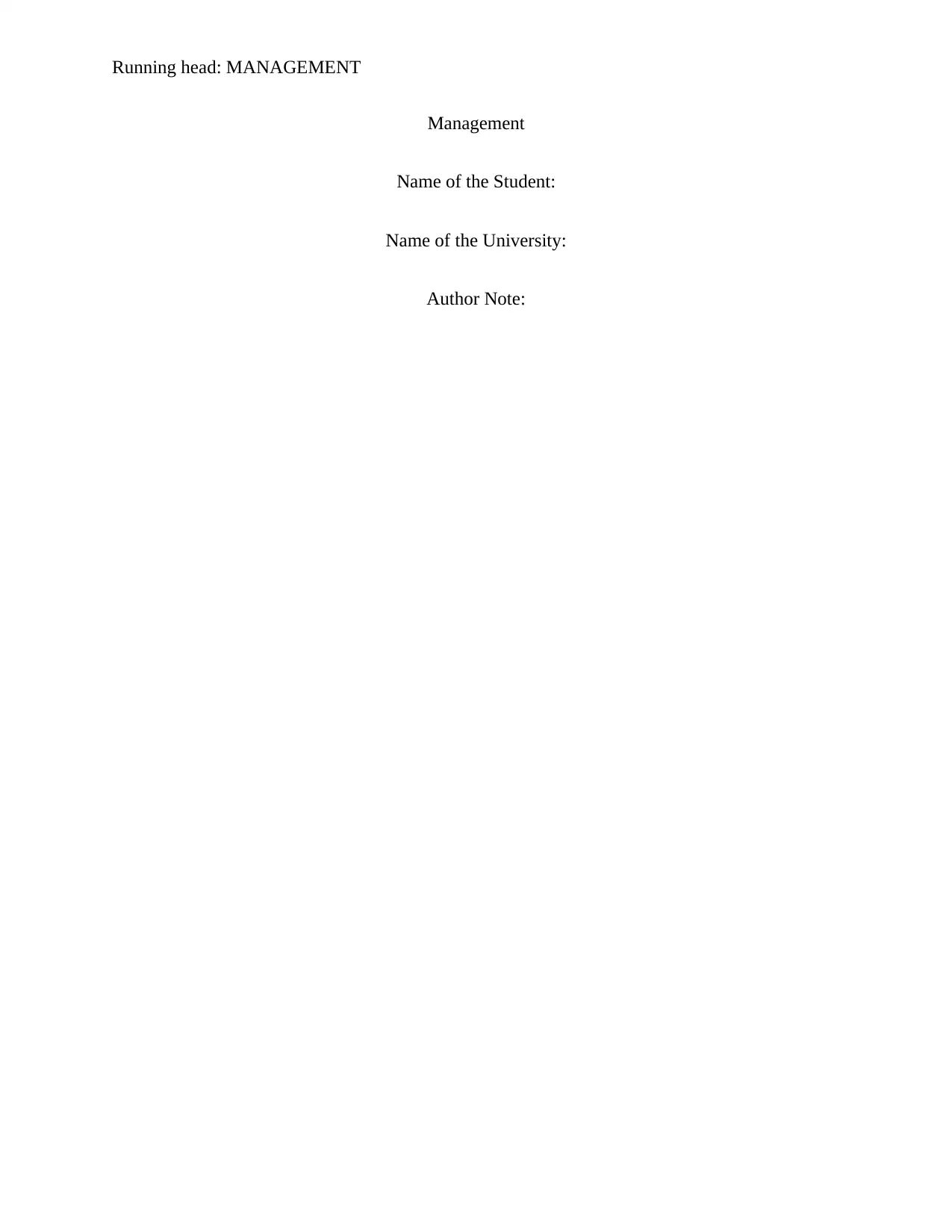
Running head: MANAGEMENT
Management
Name of the Student:
Name of the University:
Author Note:
Management
Name of the Student:
Name of the University:
Author Note:
Paraphrase This Document
Need a fresh take? Get an instant paraphrase of this document with our AI Paraphraser
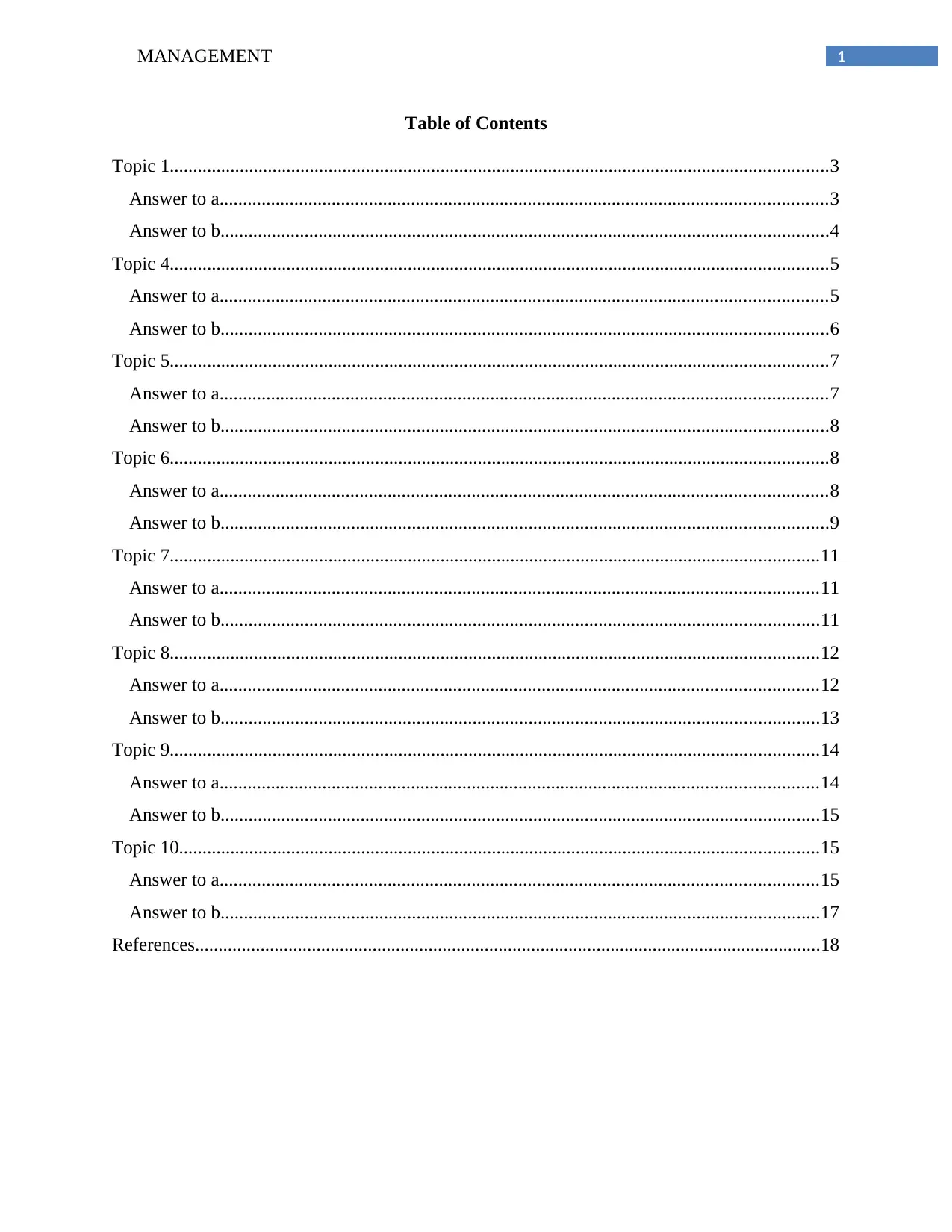
1MANAGEMENT
Table of Contents
Topic 1.............................................................................................................................................3
Answer to a..................................................................................................................................3
Answer to b..................................................................................................................................4
Topic 4.............................................................................................................................................5
Answer to a..................................................................................................................................5
Answer to b..................................................................................................................................6
Topic 5.............................................................................................................................................7
Answer to a..................................................................................................................................7
Answer to b..................................................................................................................................8
Topic 6.............................................................................................................................................8
Answer to a..................................................................................................................................8
Answer to b..................................................................................................................................9
Topic 7...........................................................................................................................................11
Answer to a................................................................................................................................11
Answer to b................................................................................................................................11
Topic 8...........................................................................................................................................12
Answer to a................................................................................................................................12
Answer to b................................................................................................................................13
Topic 9...........................................................................................................................................14
Answer to a................................................................................................................................14
Answer to b................................................................................................................................15
Topic 10.........................................................................................................................................15
Answer to a................................................................................................................................15
Answer to b................................................................................................................................17
References......................................................................................................................................18
Table of Contents
Topic 1.............................................................................................................................................3
Answer to a..................................................................................................................................3
Answer to b..................................................................................................................................4
Topic 4.............................................................................................................................................5
Answer to a..................................................................................................................................5
Answer to b..................................................................................................................................6
Topic 5.............................................................................................................................................7
Answer to a..................................................................................................................................7
Answer to b..................................................................................................................................8
Topic 6.............................................................................................................................................8
Answer to a..................................................................................................................................8
Answer to b..................................................................................................................................9
Topic 7...........................................................................................................................................11
Answer to a................................................................................................................................11
Answer to b................................................................................................................................11
Topic 8...........................................................................................................................................12
Answer to a................................................................................................................................12
Answer to b................................................................................................................................13
Topic 9...........................................................................................................................................14
Answer to a................................................................................................................................14
Answer to b................................................................................................................................15
Topic 10.........................................................................................................................................15
Answer to a................................................................................................................................15
Answer to b................................................................................................................................17
References......................................................................................................................................18

2MANAGEMENT
Topic 1
Answer to a
Management refers to the administration in an organization that might include either a
business, government body or a nonprofit organization (Zuberbier et.al 2016). Thus,
management involves the setting of strategy for an organization and at the same time
coordinating the employee efforts for accomplishing the objectives with available resources like
technological, natural, financial and human resource.
The theories of management studies that help in managing an organization are as follows:
1. Classical Theory:
The Classical Theory is a well-organized theory of management that helps an
organization in planning, staffing, organizing, directing, co-coordinating, reporting and
budgeting. The theory also allows choosing between hierarchical or linear bureaucracy and in
proper time management and division of labor.
2. Humanistic Theory:
The Humanistic Theory of management portrays the need for motivating the employees
from time to time for achieving the target within the measured time. However, the motivation
factor can come in the form of increment as well as rewards. According to this theory, employees
possess maximum power and their motivation plays an important role in reducing their stress.
3. Contingency Theory:
Topic 1
Answer to a
Management refers to the administration in an organization that might include either a
business, government body or a nonprofit organization (Zuberbier et.al 2016). Thus,
management involves the setting of strategy for an organization and at the same time
coordinating the employee efforts for accomplishing the objectives with available resources like
technological, natural, financial and human resource.
The theories of management studies that help in managing an organization are as follows:
1. Classical Theory:
The Classical Theory is a well-organized theory of management that helps an
organization in planning, staffing, organizing, directing, co-coordinating, reporting and
budgeting. The theory also allows choosing between hierarchical or linear bureaucracy and in
proper time management and division of labor.
2. Humanistic Theory:
The Humanistic Theory of management portrays the need for motivating the employees
from time to time for achieving the target within the measured time. However, the motivation
factor can come in the form of increment as well as rewards. According to this theory, employees
possess maximum power and their motivation plays an important role in reducing their stress.
3. Contingency Theory:
⊘ This is a preview!⊘
Do you want full access?
Subscribe today to unlock all pages.

Trusted by 1+ million students worldwide
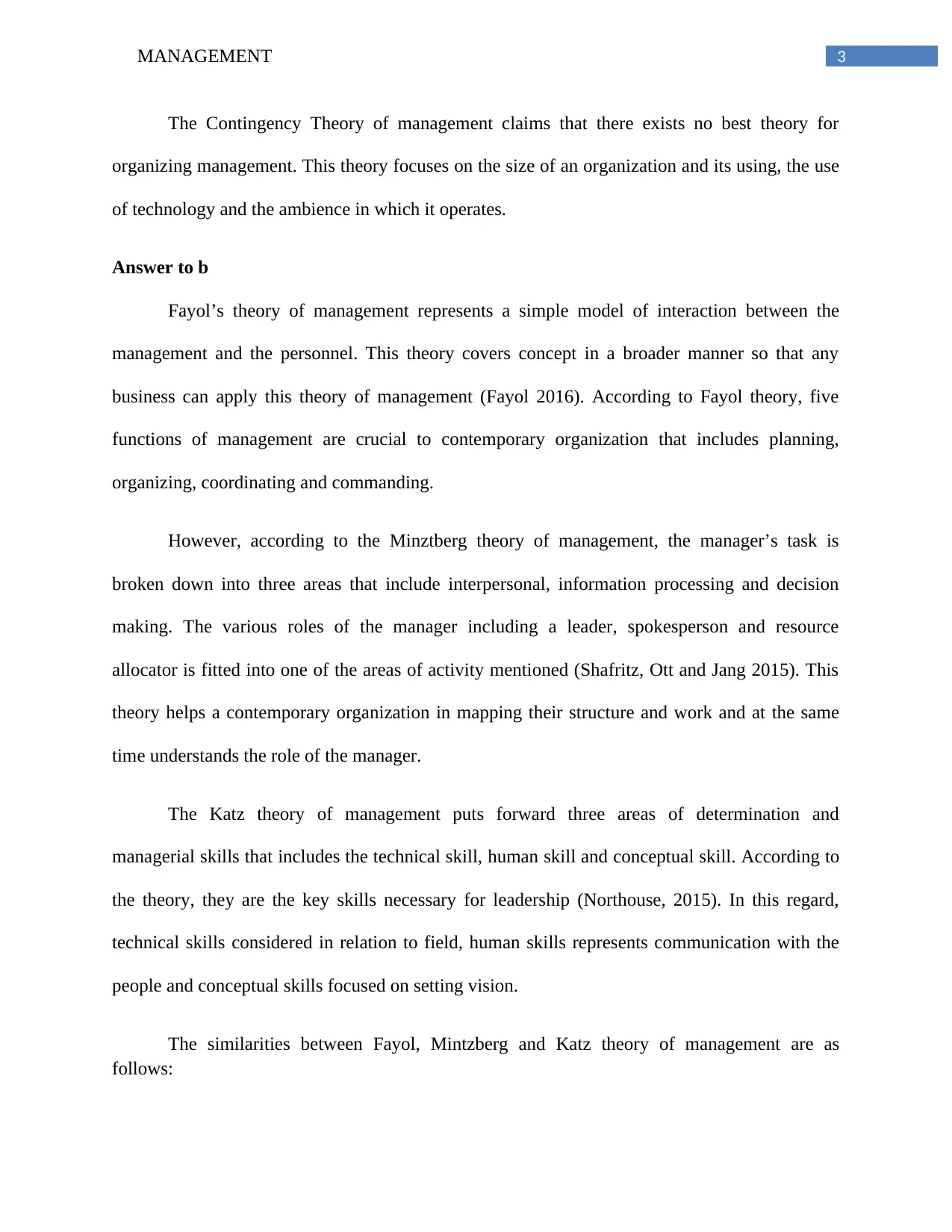
3MANAGEMENT
The Contingency Theory of management claims that there exists no best theory for
organizing management. This theory focuses on the size of an organization and its using, the use
of technology and the ambience in which it operates.
Answer to b
Fayol’s theory of management represents a simple model of interaction between the
management and the personnel. This theory covers concept in a broader manner so that any
business can apply this theory of management (Fayol 2016). According to Fayol theory, five
functions of management are crucial to contemporary organization that includes planning,
organizing, coordinating and commanding.
However, according to the Minztberg theory of management, the manager’s task is
broken down into three areas that include interpersonal, information processing and decision
making. The various roles of the manager including a leader, spokesperson and resource
allocator is fitted into one of the areas of activity mentioned (Shafritz, Ott and Jang 2015). This
theory helps a contemporary organization in mapping their structure and work and at the same
time understands the role of the manager.
The Katz theory of management puts forward three areas of determination and
managerial skills that includes the technical skill, human skill and conceptual skill. According to
the theory, they are the key skills necessary for leadership (Northouse, 2015). In this regard,
technical skills considered in relation to field, human skills represents communication with the
people and conceptual skills focused on setting vision.
The similarities between Fayol, Mintzberg and Katz theory of management are as
follows:
The Contingency Theory of management claims that there exists no best theory for
organizing management. This theory focuses on the size of an organization and its using, the use
of technology and the ambience in which it operates.
Answer to b
Fayol’s theory of management represents a simple model of interaction between the
management and the personnel. This theory covers concept in a broader manner so that any
business can apply this theory of management (Fayol 2016). According to Fayol theory, five
functions of management are crucial to contemporary organization that includes planning,
organizing, coordinating and commanding.
However, according to the Minztberg theory of management, the manager’s task is
broken down into three areas that include interpersonal, information processing and decision
making. The various roles of the manager including a leader, spokesperson and resource
allocator is fitted into one of the areas of activity mentioned (Shafritz, Ott and Jang 2015). This
theory helps a contemporary organization in mapping their structure and work and at the same
time understands the role of the manager.
The Katz theory of management puts forward three areas of determination and
managerial skills that includes the technical skill, human skill and conceptual skill. According to
the theory, they are the key skills necessary for leadership (Northouse, 2015). In this regard,
technical skills considered in relation to field, human skills represents communication with the
people and conceptual skills focused on setting vision.
The similarities between Fayol, Mintzberg and Katz theory of management are as
follows:
Paraphrase This Document
Need a fresh take? Get an instant paraphrase of this document with our AI Paraphraser
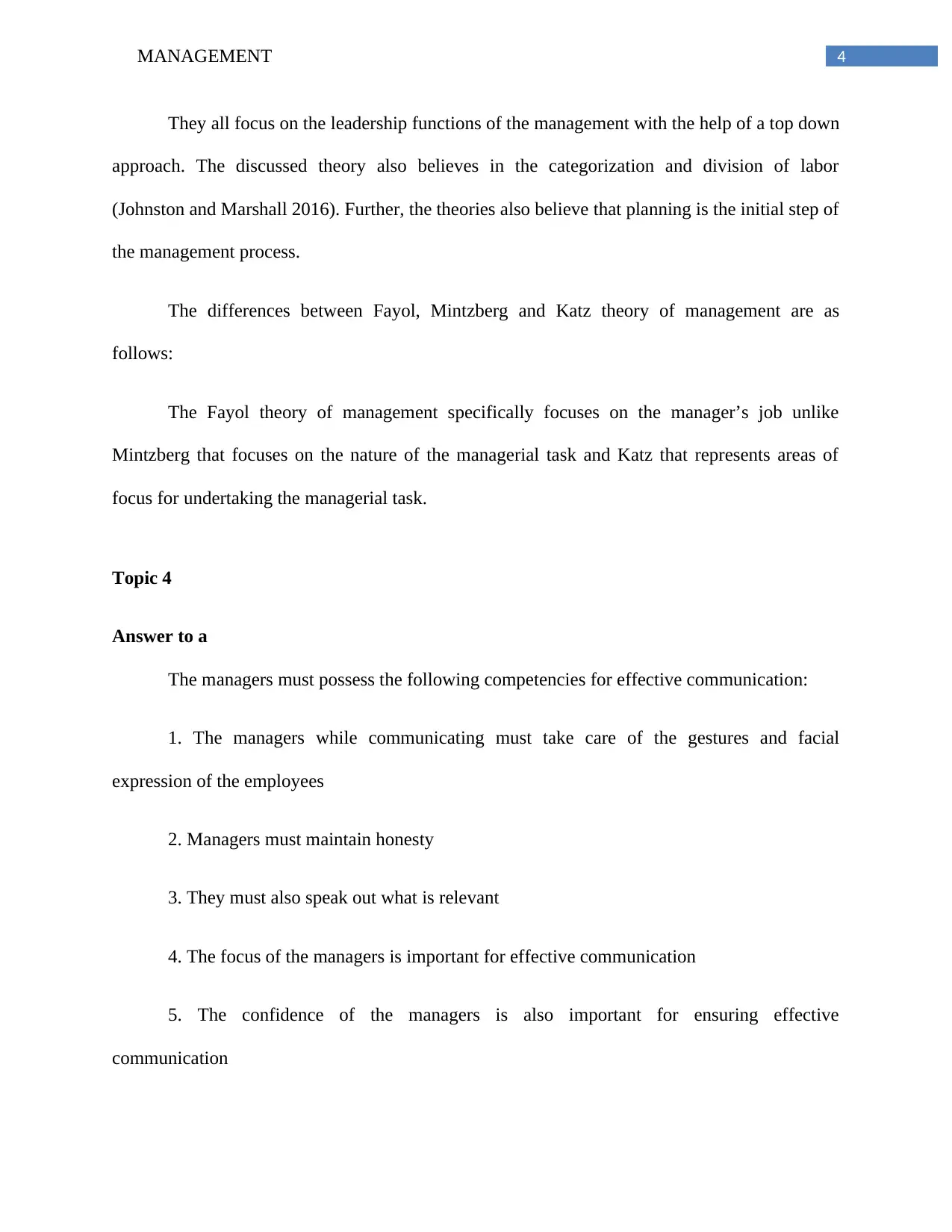
4MANAGEMENT
They all focus on the leadership functions of the management with the help of a top down
approach. The discussed theory also believes in the categorization and division of labor
(Johnston and Marshall 2016). Further, the theories also believe that planning is the initial step of
the management process.
The differences between Fayol, Mintzberg and Katz theory of management are as
follows:
The Fayol theory of management specifically focuses on the manager’s job unlike
Mintzberg that focuses on the nature of the managerial task and Katz that represents areas of
focus for undertaking the managerial task.
Topic 4
Answer to a
The managers must possess the following competencies for effective communication:
1. The managers while communicating must take care of the gestures and facial
expression of the employees
2. Managers must maintain honesty
3. They must also speak out what is relevant
4. The focus of the managers is important for effective communication
5. The confidence of the managers is also important for ensuring effective
communication
They all focus on the leadership functions of the management with the help of a top down
approach. The discussed theory also believes in the categorization and division of labor
(Johnston and Marshall 2016). Further, the theories also believe that planning is the initial step of
the management process.
The differences between Fayol, Mintzberg and Katz theory of management are as
follows:
The Fayol theory of management specifically focuses on the manager’s job unlike
Mintzberg that focuses on the nature of the managerial task and Katz that represents areas of
focus for undertaking the managerial task.
Topic 4
Answer to a
The managers must possess the following competencies for effective communication:
1. The managers while communicating must take care of the gestures and facial
expression of the employees
2. Managers must maintain honesty
3. They must also speak out what is relevant
4. The focus of the managers is important for effective communication
5. The confidence of the managers is also important for ensuring effective
communication
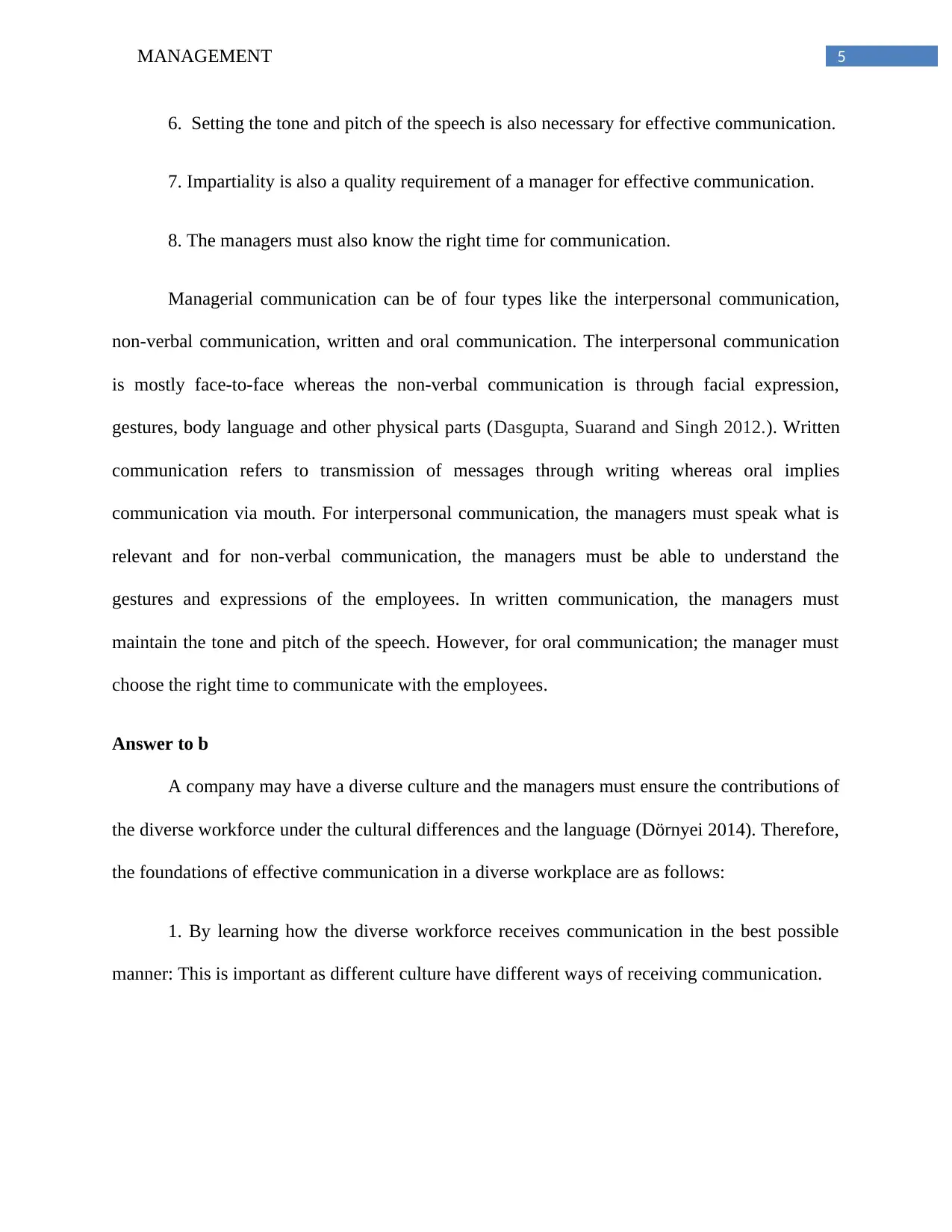
5MANAGEMENT
6. Setting the tone and pitch of the speech is also necessary for effective communication.
7. Impartiality is also a quality requirement of a manager for effective communication.
8. The managers must also know the right time for communication.
Managerial communication can be of four types like the interpersonal communication,
non-verbal communication, written and oral communication. The interpersonal communication
is mostly face-to-face whereas the non-verbal communication is through facial expression,
gestures, body language and other physical parts (Dasgupta, Suarand and Singh 2012.). Written
communication refers to transmission of messages through writing whereas oral implies
communication via mouth. For interpersonal communication, the managers must speak what is
relevant and for non-verbal communication, the managers must be able to understand the
gestures and expressions of the employees. In written communication, the managers must
maintain the tone and pitch of the speech. However, for oral communication; the manager must
choose the right time to communicate with the employees.
Answer to b
A company may have a diverse culture and the managers must ensure the contributions of
the diverse workforce under the cultural differences and the language (Dörnyei 2014). Therefore,
the foundations of effective communication in a diverse workplace are as follows:
1. By learning how the diverse workforce receives communication in the best possible
manner: This is important as different culture have different ways of receiving communication.
6. Setting the tone and pitch of the speech is also necessary for effective communication.
7. Impartiality is also a quality requirement of a manager for effective communication.
8. The managers must also know the right time for communication.
Managerial communication can be of four types like the interpersonal communication,
non-verbal communication, written and oral communication. The interpersonal communication
is mostly face-to-face whereas the non-verbal communication is through facial expression,
gestures, body language and other physical parts (Dasgupta, Suarand and Singh 2012.). Written
communication refers to transmission of messages through writing whereas oral implies
communication via mouth. For interpersonal communication, the managers must speak what is
relevant and for non-verbal communication, the managers must be able to understand the
gestures and expressions of the employees. In written communication, the managers must
maintain the tone and pitch of the speech. However, for oral communication; the manager must
choose the right time to communicate with the employees.
Answer to b
A company may have a diverse culture and the managers must ensure the contributions of
the diverse workforce under the cultural differences and the language (Dörnyei 2014). Therefore,
the foundations of effective communication in a diverse workplace are as follows:
1. By learning how the diverse workforce receives communication in the best possible
manner: This is important as different culture have different ways of receiving communication.
⊘ This is a preview!⊘
Do you want full access?
Subscribe today to unlock all pages.

Trusted by 1+ million students worldwide
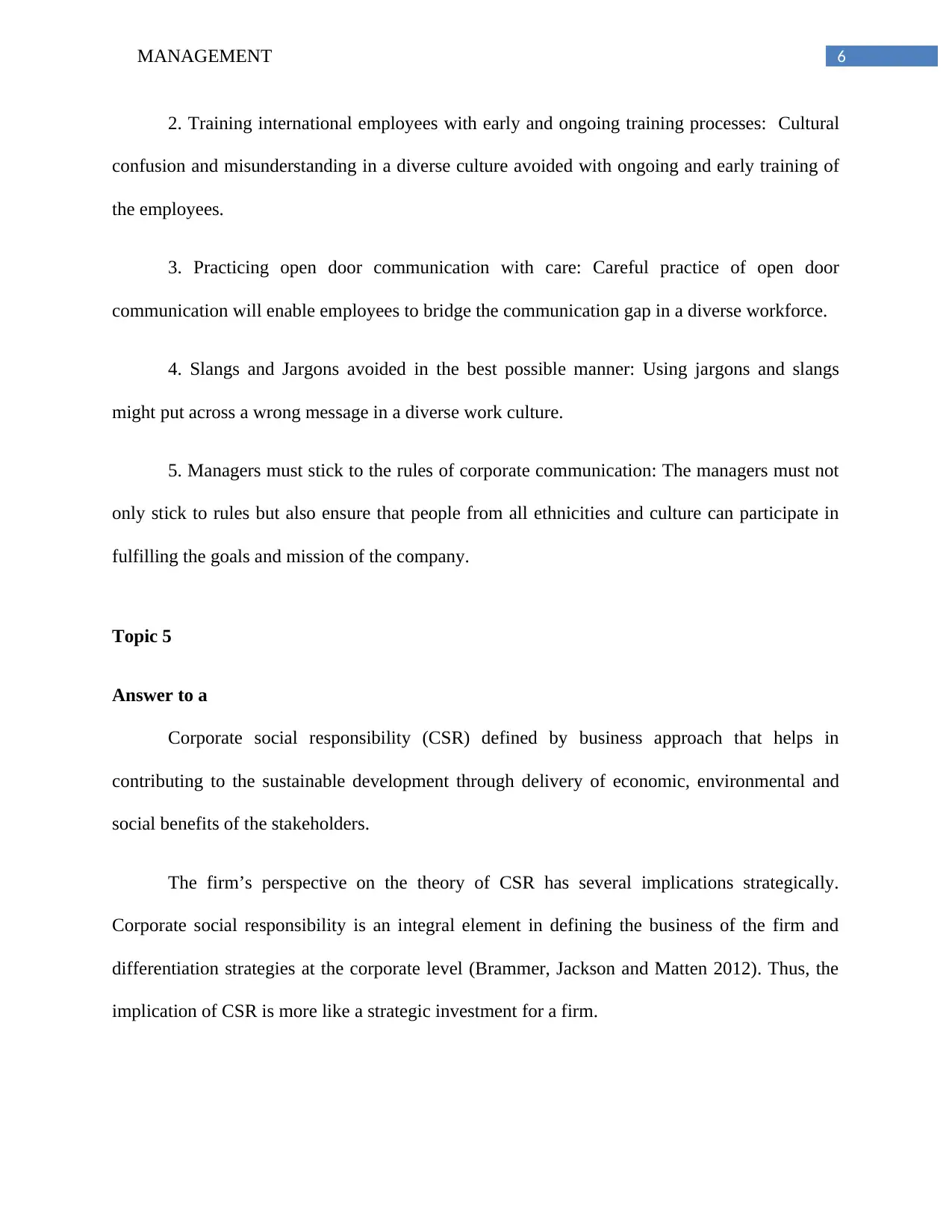
6MANAGEMENT
2. Training international employees with early and ongoing training processes: Cultural
confusion and misunderstanding in a diverse culture avoided with ongoing and early training of
the employees.
3. Practicing open door communication with care: Careful practice of open door
communication will enable employees to bridge the communication gap in a diverse workforce.
4. Slangs and Jargons avoided in the best possible manner: Using jargons and slangs
might put across a wrong message in a diverse work culture.
5. Managers must stick to the rules of corporate communication: The managers must not
only stick to rules but also ensure that people from all ethnicities and culture can participate in
fulfilling the goals and mission of the company.
Topic 5
Answer to a
Corporate social responsibility (CSR) defined by business approach that helps in
contributing to the sustainable development through delivery of economic, environmental and
social benefits of the stakeholders.
The firm’s perspective on the theory of CSR has several implications strategically.
Corporate social responsibility is an integral element in defining the business of the firm and
differentiation strategies at the corporate level (Brammer, Jackson and Matten 2012). Thus, the
implication of CSR is more like a strategic investment for a firm.
2. Training international employees with early and ongoing training processes: Cultural
confusion and misunderstanding in a diverse culture avoided with ongoing and early training of
the employees.
3. Practicing open door communication with care: Careful practice of open door
communication will enable employees to bridge the communication gap in a diverse workforce.
4. Slangs and Jargons avoided in the best possible manner: Using jargons and slangs
might put across a wrong message in a diverse work culture.
5. Managers must stick to the rules of corporate communication: The managers must not
only stick to rules but also ensure that people from all ethnicities and culture can participate in
fulfilling the goals and mission of the company.
Topic 5
Answer to a
Corporate social responsibility (CSR) defined by business approach that helps in
contributing to the sustainable development through delivery of economic, environmental and
social benefits of the stakeholders.
The firm’s perspective on the theory of CSR has several implications strategically.
Corporate social responsibility is an integral element in defining the business of the firm and
differentiation strategies at the corporate level (Brammer, Jackson and Matten 2012). Thus, the
implication of CSR is more like a strategic investment for a firm.
Paraphrase This Document
Need a fresh take? Get an instant paraphrase of this document with our AI Paraphraser
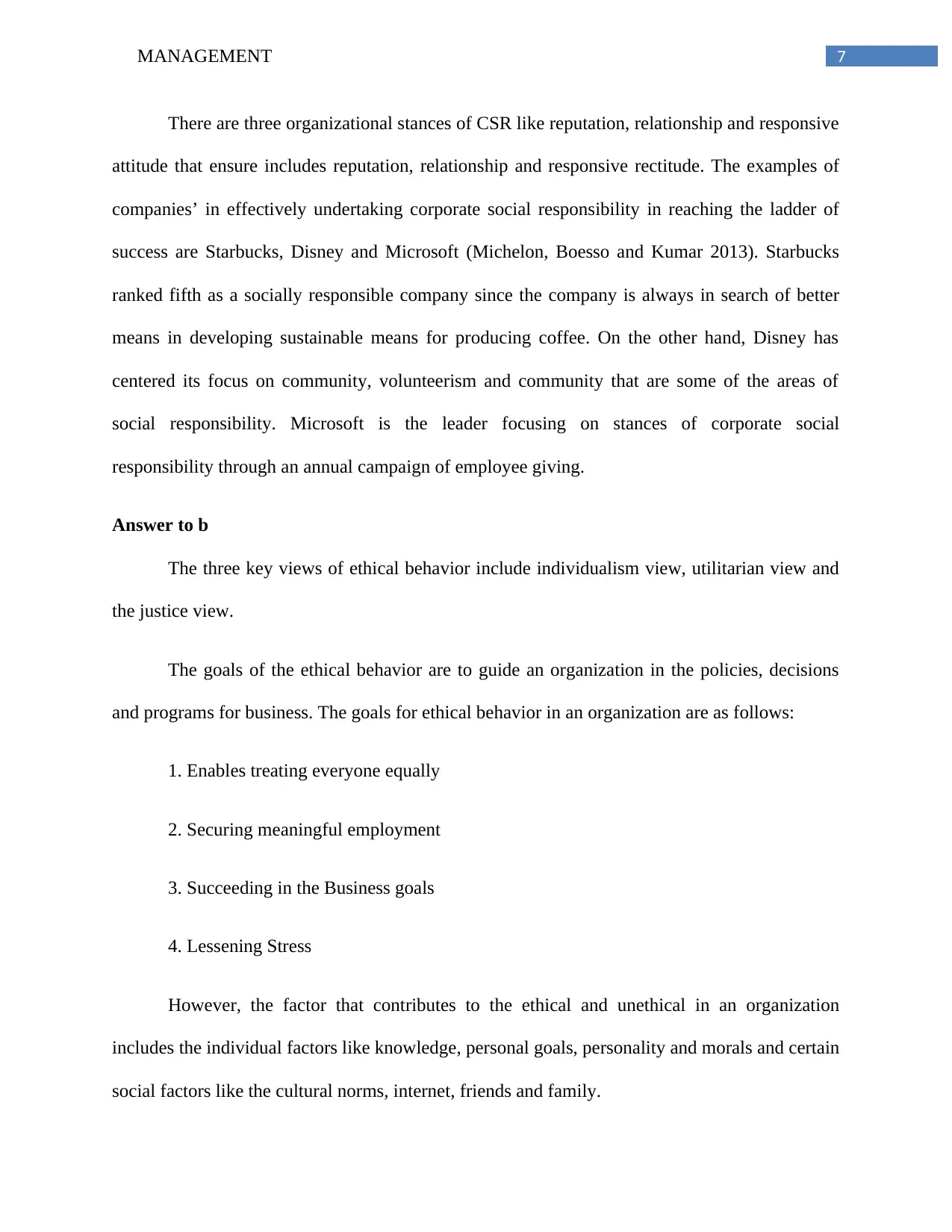
7MANAGEMENT
There are three organizational stances of CSR like reputation, relationship and responsive
attitude that ensure includes reputation, relationship and responsive rectitude. The examples of
companies’ in effectively undertaking corporate social responsibility in reaching the ladder of
success are Starbucks, Disney and Microsoft (Michelon, Boesso and Kumar 2013). Starbucks
ranked fifth as a socially responsible company since the company is always in search of better
means in developing sustainable means for producing coffee. On the other hand, Disney has
centered its focus on community, volunteerism and community that are some of the areas of
social responsibility. Microsoft is the leader focusing on stances of corporate social
responsibility through an annual campaign of employee giving.
Answer to b
The three key views of ethical behavior include individualism view, utilitarian view and
the justice view.
The goals of the ethical behavior are to guide an organization in the policies, decisions
and programs for business. The goals for ethical behavior in an organization are as follows:
1. Enables treating everyone equally
2. Securing meaningful employment
3. Succeeding in the Business goals
4. Lessening Stress
However, the factor that contributes to the ethical and unethical in an organization
includes the individual factors like knowledge, personal goals, personality and morals and certain
social factors like the cultural norms, internet, friends and family.
There are three organizational stances of CSR like reputation, relationship and responsive
attitude that ensure includes reputation, relationship and responsive rectitude. The examples of
companies’ in effectively undertaking corporate social responsibility in reaching the ladder of
success are Starbucks, Disney and Microsoft (Michelon, Boesso and Kumar 2013). Starbucks
ranked fifth as a socially responsible company since the company is always in search of better
means in developing sustainable means for producing coffee. On the other hand, Disney has
centered its focus on community, volunteerism and community that are some of the areas of
social responsibility. Microsoft is the leader focusing on stances of corporate social
responsibility through an annual campaign of employee giving.
Answer to b
The three key views of ethical behavior include individualism view, utilitarian view and
the justice view.
The goals of the ethical behavior are to guide an organization in the policies, decisions
and programs for business. The goals for ethical behavior in an organization are as follows:
1. Enables treating everyone equally
2. Securing meaningful employment
3. Succeeding in the Business goals
4. Lessening Stress
However, the factor that contributes to the ethical and unethical in an organization
includes the individual factors like knowledge, personal goals, personality and morals and certain
social factors like the cultural norms, internet, friends and family.
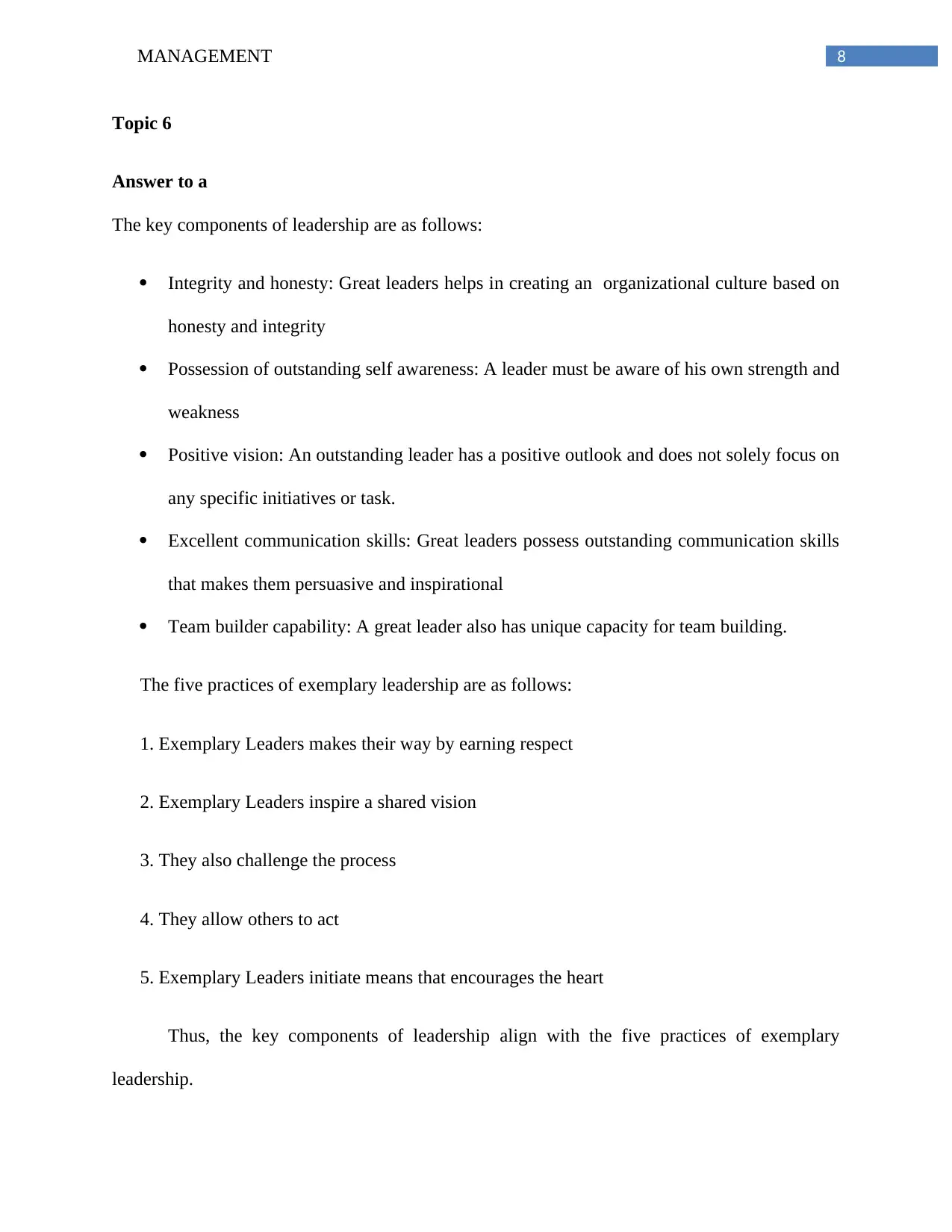
8MANAGEMENT
Topic 6
Answer to a
The key components of leadership are as follows:
Integrity and honesty: Great leaders helps in creating an organizational culture based on
honesty and integrity
Possession of outstanding self awareness: A leader must be aware of his own strength and
weakness
Positive vision: An outstanding leader has a positive outlook and does not solely focus on
any specific initiatives or task.
Excellent communication skills: Great leaders possess outstanding communication skills
that makes them persuasive and inspirational
Team builder capability: A great leader also has unique capacity for team building.
The five practices of exemplary leadership are as follows:
1. Exemplary Leaders makes their way by earning respect
2. Exemplary Leaders inspire a shared vision
3. They also challenge the process
4. They allow others to act
5. Exemplary Leaders initiate means that encourages the heart
Thus, the key components of leadership align with the five practices of exemplary
leadership.
Topic 6
Answer to a
The key components of leadership are as follows:
Integrity and honesty: Great leaders helps in creating an organizational culture based on
honesty and integrity
Possession of outstanding self awareness: A leader must be aware of his own strength and
weakness
Positive vision: An outstanding leader has a positive outlook and does not solely focus on
any specific initiatives or task.
Excellent communication skills: Great leaders possess outstanding communication skills
that makes them persuasive and inspirational
Team builder capability: A great leader also has unique capacity for team building.
The five practices of exemplary leadership are as follows:
1. Exemplary Leaders makes their way by earning respect
2. Exemplary Leaders inspire a shared vision
3. They also challenge the process
4. They allow others to act
5. Exemplary Leaders initiate means that encourages the heart
Thus, the key components of leadership align with the five practices of exemplary
leadership.
⊘ This is a preview!⊘
Do you want full access?
Subscribe today to unlock all pages.

Trusted by 1+ million students worldwide
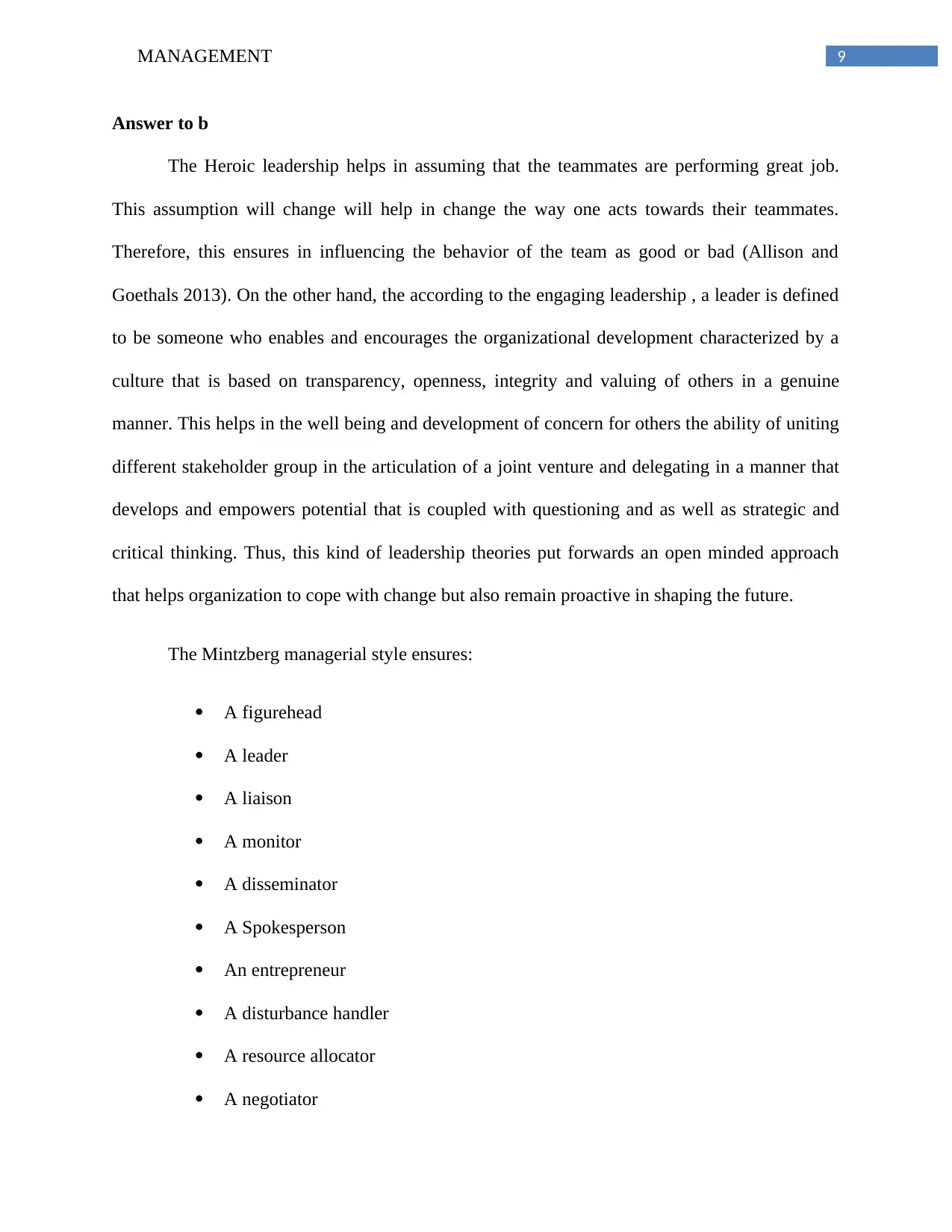
9MANAGEMENT
Answer to b
The Heroic leadership helps in assuming that the teammates are performing great job.
This assumption will change will help in change the way one acts towards their teammates.
Therefore, this ensures in influencing the behavior of the team as good or bad (Allison and
Goethals 2013). On the other hand, the according to the engaging leadership , a leader is defined
to be someone who enables and encourages the organizational development characterized by a
culture that is based on transparency, openness, integrity and valuing of others in a genuine
manner. This helps in the well being and development of concern for others the ability of uniting
different stakeholder group in the articulation of a joint venture and delegating in a manner that
develops and empowers potential that is coupled with questioning and as well as strategic and
critical thinking. Thus, this kind of leadership theories put forwards an open minded approach
that helps organization to cope with change but also remain proactive in shaping the future.
The Mintzberg managerial style ensures:
A figurehead
A leader
A liaison
A monitor
A disseminator
A Spokesperson
An entrepreneur
A disturbance handler
A resource allocator
A negotiator
Answer to b
The Heroic leadership helps in assuming that the teammates are performing great job.
This assumption will change will help in change the way one acts towards their teammates.
Therefore, this ensures in influencing the behavior of the team as good or bad (Allison and
Goethals 2013). On the other hand, the according to the engaging leadership , a leader is defined
to be someone who enables and encourages the organizational development characterized by a
culture that is based on transparency, openness, integrity and valuing of others in a genuine
manner. This helps in the well being and development of concern for others the ability of uniting
different stakeholder group in the articulation of a joint venture and delegating in a manner that
develops and empowers potential that is coupled with questioning and as well as strategic and
critical thinking. Thus, this kind of leadership theories put forwards an open minded approach
that helps organization to cope with change but also remain proactive in shaping the future.
The Mintzberg managerial style ensures:
A figurehead
A leader
A liaison
A monitor
A disseminator
A Spokesperson
An entrepreneur
A disturbance handler
A resource allocator
A negotiator
Paraphrase This Document
Need a fresh take? Get an instant paraphrase of this document with our AI Paraphraser
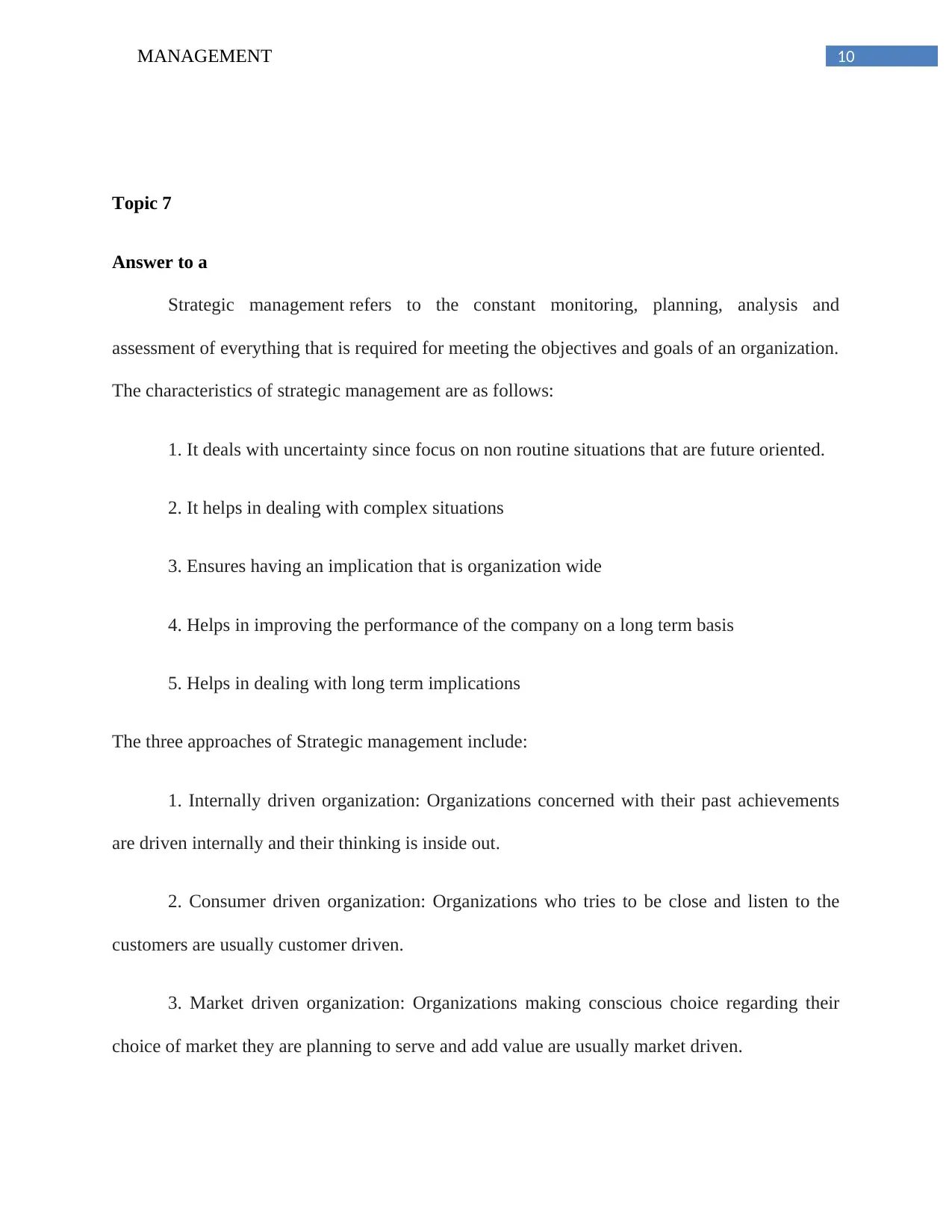
10MANAGEMENT
Topic 7
Answer to a
Strategic management refers to the constant monitoring, planning, analysis and
assessment of everything that is required for meeting the objectives and goals of an organization.
The characteristics of strategic management are as follows:
1. It deals with uncertainty since focus on non routine situations that are future oriented.
2. It helps in dealing with complex situations
3. Ensures having an implication that is organization wide
4. Helps in improving the performance of the company on a long term basis
5. Helps in dealing with long term implications
The three approaches of Strategic management include:
1. Internally driven organization: Organizations concerned with their past achievements
are driven internally and their thinking is inside out.
2. Consumer driven organization: Organizations who tries to be close and listen to the
customers are usually customer driven.
3. Market driven organization: Organizations making conscious choice regarding their
choice of market they are planning to serve and add value are usually market driven.
Topic 7
Answer to a
Strategic management refers to the constant monitoring, planning, analysis and
assessment of everything that is required for meeting the objectives and goals of an organization.
The characteristics of strategic management are as follows:
1. It deals with uncertainty since focus on non routine situations that are future oriented.
2. It helps in dealing with complex situations
3. Ensures having an implication that is organization wide
4. Helps in improving the performance of the company on a long term basis
5. Helps in dealing with long term implications
The three approaches of Strategic management include:
1. Internally driven organization: Organizations concerned with their past achievements
are driven internally and their thinking is inside out.
2. Consumer driven organization: Organizations who tries to be close and listen to the
customers are usually customer driven.
3. Market driven organization: Organizations making conscious choice regarding their
choice of market they are planning to serve and add value are usually market driven.
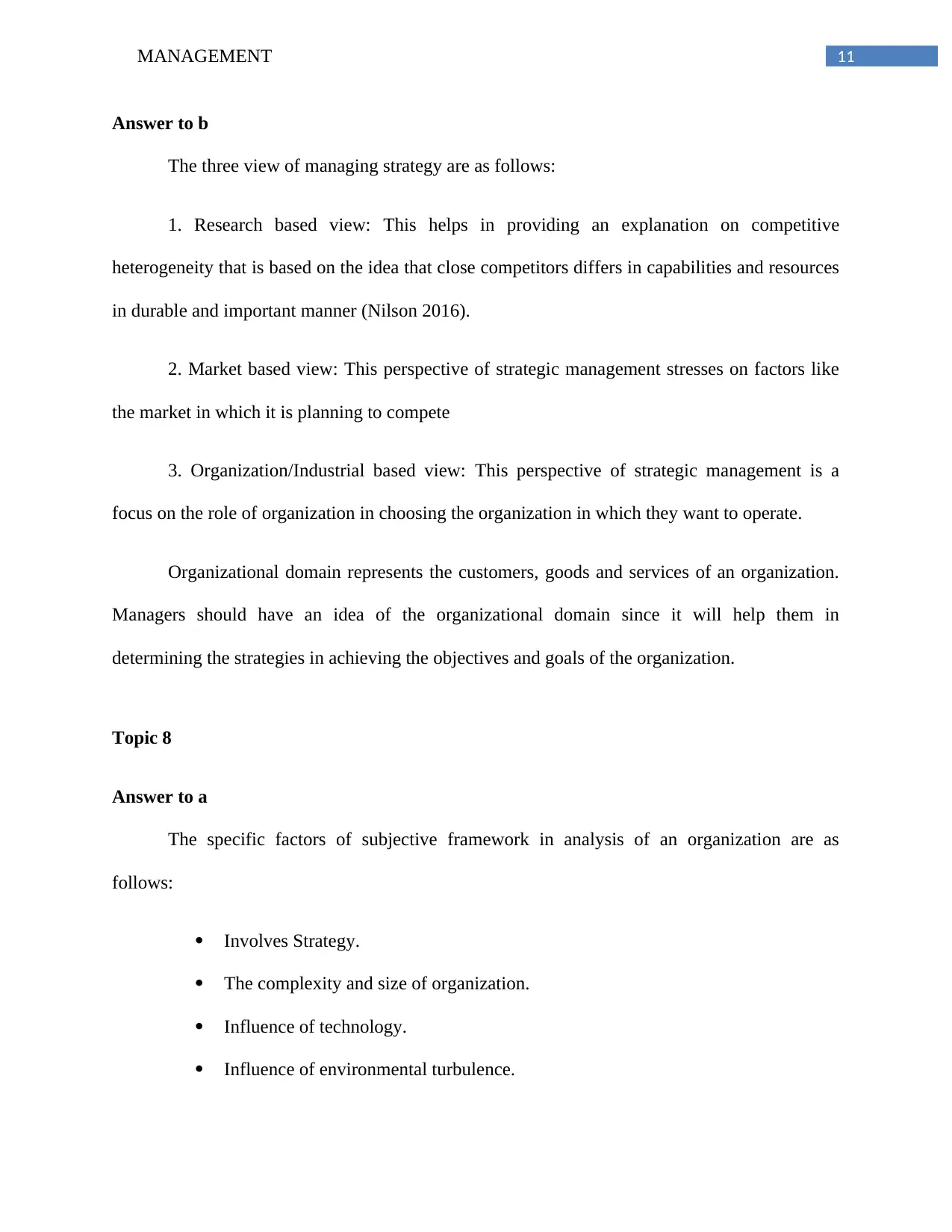
11MANAGEMENT
Answer to b
The three view of managing strategy are as follows:
1. Research based view: This helps in providing an explanation on competitive
heterogeneity that is based on the idea that close competitors differs in capabilities and resources
in durable and important manner (Nilson 2016).
2. Market based view: This perspective of strategic management stresses on factors like
the market in which it is planning to compete
3. Organization/Industrial based view: This perspective of strategic management is a
focus on the role of organization in choosing the organization in which they want to operate.
Organizational domain represents the customers, goods and services of an organization.
Managers should have an idea of the organizational domain since it will help them in
determining the strategies in achieving the objectives and goals of the organization.
Topic 8
Answer to a
The specific factors of subjective framework in analysis of an organization are as
follows:
Involves Strategy.
The complexity and size of organization.
Influence of technology.
Influence of environmental turbulence.
Answer to b
The three view of managing strategy are as follows:
1. Research based view: This helps in providing an explanation on competitive
heterogeneity that is based on the idea that close competitors differs in capabilities and resources
in durable and important manner (Nilson 2016).
2. Market based view: This perspective of strategic management stresses on factors like
the market in which it is planning to compete
3. Organization/Industrial based view: This perspective of strategic management is a
focus on the role of organization in choosing the organization in which they want to operate.
Organizational domain represents the customers, goods and services of an organization.
Managers should have an idea of the organizational domain since it will help them in
determining the strategies in achieving the objectives and goals of the organization.
Topic 8
Answer to a
The specific factors of subjective framework in analysis of an organization are as
follows:
Involves Strategy.
The complexity and size of organization.
Influence of technology.
Influence of environmental turbulence.
⊘ This is a preview!⊘
Do you want full access?
Subscribe today to unlock all pages.

Trusted by 1+ million students worldwide
1 out of 19
Related Documents
Your All-in-One AI-Powered Toolkit for Academic Success.
+13062052269
info@desklib.com
Available 24*7 on WhatsApp / Email
![[object Object]](/_next/static/media/star-bottom.7253800d.svg)
Unlock your academic potential
Copyright © 2020–2025 A2Z Services. All Rights Reserved. Developed and managed by ZUCOL.





